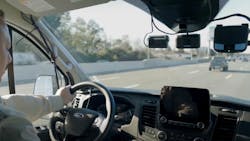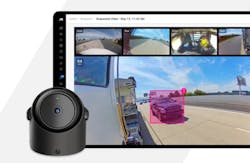All AI dashcams the true winner in technology comparison study
According to S&P Global Market Intelligence’s Voice of Enterprise survey, 64% of commercial trucking companies monitor driver behavior. There is more than one way to monitor harsh braking or speeding, but to quell distracted driving, fleets typically will employ inward or dual-facing cameras. These cameras not only record what's going on in and outside of the cab, but now use artificial intelligence to detect when a driver is doing something they shouldn’t. The system alerts the offending driver, and if desired, fleet management as well.
Fleets that adopt the technology often point out the goal is not to get anyone in trouble, but to correct negative and costly behavior. At the low end, too much harsh braking is hell on brakes and would lead to more frequent change outs. At worst, a driver distracted by their phone could cause a fatal accident—with the fleet's fate at the mercy of a civil jury.
Fleet management solution provider Motive (formerly KeepTruckin) has spent much of this year making the case that dashcams can save both lives and money. The main reason is that monitoring and detecting bad behavior allows management to intervene and coach up drivers before the worst happens. In the company's first State of Safety Report, 56% of the 1,110 fleets surveyed asserted driver coaching programs led to fewer unsafe driving behaviors, while 53% reported fewer accidents. Using these preventive measures also yields insurance savings, 44% said.
To weed out dangerous driving practices, the fleet must first know it's happening. A recent study funded by Motive suggests its AI dashcams are the most vigilant in respect to detecting distracted driving. A controlled test track study conducted by the Virginia Tech Transportation Institute (VTTI) found that Motive’s DC-54 AI Dashcam generated unsafe driving alerts three to four times more often than Samsara’s HW-CM32 Dual-facing Dash Cam and the Lytx Drive Cam SF400.
The researchers tracked six unsafe driving behaviors, with the data collected from March 13 to May 2, 2023. These include:
- Phone calls
- Phone in lap
- Texting
- Rolling stops
- Not wearing a seat belt
- Following too close
According to the 109-page report, Motive’s DC-54 successfully alerted drivers 86% of the time, while Lytx was at 32% and Samsara at 21%.
One of the key reasons for the study was to tamp down distracted driving and mitigate bad driver habits that could lead to injuries and fatalities. The National Highway Traffic Safety Administration reported that from 2020 to 2021, motor vehicle traffic fatalities increased 10.5%, from 38,824 to 42,915
“There is an epidemic of road accidents and fatalities that continues to worsen but, with advancements in AI, they should be getting better. Even worse, the principal cause of these accidents—including distracted and unsafe driving behavior—are 100% preventable,” said Shoaib Makani, co-founder and CEO at Motive. “The results of VTTI’s research are not just about comparing products. They show that these technologies don’t all perform the same, which can have major implications for accident prevention.”
To mimic real-world conditions, VTTI conducted the tests across three placement locations during the day, dusk, and night, using three different locations for the dash cams. Installation was done by certified, professional third-party installer in accordance with each camera provider’s standards. Additionally, VTTI carefully controlled factors that could influence system performance, such as weather conditions, driver identity, and system placement, to maintain the integrity of the study.
Breaking down the results, Motive appeared to have the edge in four areas:
- Phone Call Overall Alert Rates: Motive: 95%, Samsara: 38%, Lytx: 28%
- Texting Overall Alert Rates: Motive: 71%, Samsara: 30%, Lytx: 13%
- Rolling Stop: Motive 77%, Samsara 0% (The study excluded Lytx's rolling stop alerts due to Lytx’s decision to deactivate the alert feature for all customers during the study period.)
- Close Following Overall Alert Rates: Motive: 67%, Samsara: 18%, Lytx: 28%
Motive and Lytx both scored 100% on seat belt use, while Samsara did not trigger an alert during the study.
Lytx questions study efficacy
When asked for comment on the study’s results, Samsara declined comment, while Lytx pushed back.
“This study, similar to the previous one also funded by Motive, does not compare precision rates,” noted Jim Brady, VP of product management at Lytx. “It only reports how often a behavior is captured.”
He added that not accounting for the precision of correct alerts misses possible false positives.
“It is entirely possible for a device to capture more events at the expense of being significantly noisier,” Brady said.
VTTI did monitor for false alerts and did not observe any during the test, but acknowledged the study “was not designed to measure false positives,” which would require “a different research protocol.”
A Lytx spokesperson cautioned that drivers who receive too many false positives on the road may suffer from “alert fatigue” and end up ignoring all alerts. They see the system as essentially a “boy who cried wolf.” The spokesperson said Lytx’ alerts are programmed in a way to change the driver’s behavior to lower the risk of collision, as opposed to triggering as quickly as possible.
Brady also explained that confining the study to six selected unsafe behaviors leaves out important context regarding Lytx’s MV+AI technology, which he said “is also capable of detecting additional risks, including inattentive driving, lane departure, speeding, critical distance, lens obstruction, and distractions such as smoking, eating, and drinking.”
The controlled track and small sample size also may have skewed the results. According to Brady, “Lytx customers enjoy 95% or greater precision in real world environments, the highest in the industry across the widest portfolio of alert types.”
That data, he said, was based on tens of thousands of events per week and currently has over 221 billion miles of driving data.
Highlighting AI dashcam benefits
Like with any new technology, fleets will likely pilot one or more of these solutions to find out which works for their specific region and application. Which option they choose, be it Motive, Lytx, Samasara, or another product, is less important than vetting the technology in general.
“VTTI conducts research to first and foremost save lives, from driver to passenger to pedestrian," said Susan Soccolich, VTTI Senior Researcher. "Studies like this one can help progress safety in the transportation industry by identifying situations where technologies can improve its real-time alerts of unsafe behaviors to drivers."
Even since the study, Motive has improved its own technology. Earlier this year, Motive updated its AI Dashcams’ ability to detect collisions and camera obstructions or improper installations, as well as identify stop sign violations, unsafe lane changes, distracted and drowsy driving. In June, Motive also launched the AI Omnicam, a high-definition (1080p) camera designed to provide fleets with 360-degree vehicle visibility when paired with the dashcam. Motive reported fleets pairing their dashcams with driver coaching have reduced accidents by 22%, with up to a 10x ROI.
That ROI can be nearly unquantifiable if the dashcams prevents the loss of life, or at least if a fleet's driver was not responsible. By watching a truck’s side and rear, the Omnicam can also provide exculpatory evidence in the event of side- and rear crashes. Without a clear view of the circumstances, a fleet could be held responsible for crashes even when not at fault, which could result in a nuclear verdict.
“These AI Dashcams are worth a million dollars,” said Reliable Carriers CEO Tom Abrams, about Motive's AI dashcams two years ago (when the company was KeepTruckin). “There’s simply no price you can put on how valuable these cameras are to our business.”
According to Marathon Strategies, the term “nuclear” underscores the current trend in civil damages, arguing that juries are now awarding “thermonuclear verdicts.” Corporate nuclear verdicts rose from $4.9 billion to $18.3 billion from 2020 to 2022. Last year, 20 verdicts crossed the $100 million threshold, with four passing $1 billion.
In the case of any crash, AI dash cams act as an "exoneration tool," explained Jeff Mendenhall, director of fleet data management at Foundation Building Materials. Prior to deploying Samsara's dashcams, the fleet (which as the name suggests hauls construction materials) would settle following accidents even if their driver was not at fault. Now they can prove who was truly at fault.
And with the ability to coach up their drivers, distracted driving is less of a problem.
Mendenhall said that after deploying Samsara’s inward facing cameras, the fleet detected 800 different events from 300 drivers. After reminding drivers they could be fired for these actions, the number of alerts dropped to zero within three days.
This story originally appeared on FleetMaintenance.com.

